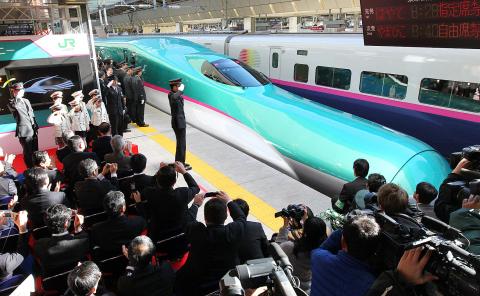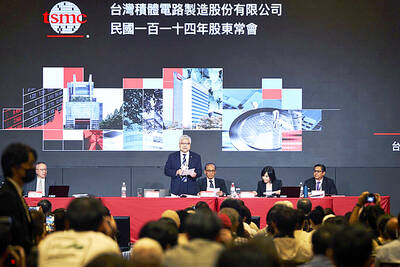Japan’s latest bullet train, the thin-nosed Hayabusa or Falcon, made its 300kph debut yesterday, boasting a luxury carriage modeled on airline business class.
Japan has built up a network of cutting-edge Shinkansen train lines since the 1960s that criss-cross the island nation and now hopes to sell the infrastructure technology abroad, including to the US.
The latest ultra-fast tech marvel will make two trips a day from Tokyo to Aomori, a scenic rural backwater on the northern tip of the main Honshu island that has until now been off Japan’s bullet train map. It will also make one more trip a day to Sendai, located between Tokyo and Aomori.

Photo: AFP
Mutsutake Otsuka, chairman of East Japan Railway Co (JR East), stressed the engineering sophistication of the new ride.
“To the best of our ability, we will strive to improve Hayabusa’s passenger comfort, safety and -environmental friendliness, not just its speed,” he told hundreds of people who came to Tokyo station to see the futuristic train.
The mood at the launch was dampened slightly by a seven minute delay to the first service after a passenger fell from the platform at Tokyo station, where more than 1,000 train hobbyists rushed to take pictures.
The train was not moving at the time and the man climbed back up to the platform unaided.
The green-and-silver E5 series Hayabusa travels at up to 300kph to make the 675km trip to Aomori in three hours and 10 minutes. From next year, it will push its top speed to 320kph to become Japan’s fastest train.
Passengers will glide quietly along the straight stretches and tunnels that cut through Japan’s mountainous countryside, said JR East, which has heavily promoted the launch of the new service.
Those willing to pay ¥26,360 (US$320) for a one-way trip can enjoy the comfort of a “GranClass” car, where a cabin attendant will serve them drinks and food in their deeply reclining leather seats on thick woollen carpets.
To promote the service, the train company has also heavily advertised Aomori as a tourist destination, praising its landscape, seafood and winter snow.
Japan’s ultra-fast, frequent and punctual bullet trains have made them the preferred choice for many travelers, rather than flying or road travel, ever since the first Shinkansen was launched in time for the 1964 Tokyo Olympics.
However, as Japan, and its railway companies, struggle with a fast-graying and shrinking population and falling domestic demand, the government and industry are aggressively seeking to promote the bullet trains abroad.
Japan has in the past sold Shinkansen technology to Taiwan and hopes to capture other overseas markets, such as Brazil and Vietnam, but faces stiff competition from train manufacturers in China, France and Germany.
The biggest prize is a future high-speed US rail network that US President Barack Obama has promoted, to be backed by US$13 billion in public funding.
California’s then-governor Arnold Schwarzenegger was treated to an early test ride on the Hayabusa when he visited Japan in September.
Japan has also been developing a magnetic levitation or maglev train that, its operator says, reached a world record speed of 581kph in 2003 on a test track near Mount Fuji in Tsuru, west of Tokyo.
The plan is to launch maglev services between Tokyo and the central city of Nagoya by 2027. By 2045 they are expected to link Tokyo with the main western city of Osaka in just 67 minutes, compared with the current two hours 25 minutes.

CAUTIOUS RECOVERY: While the manufacturing sector returned to growth amid the US-China trade truce, firms remain wary as uncertainty clouds the outlook, the CIER said The local manufacturing sector returned to expansion last month, as the official purchasing managers’ index (PMI) rose 2.1 points to 51.0, driven by a temporary easing in US-China trade tensions, the Chung-Hua Institution for Economic Research (CIER, 中華經濟研究院) said yesterday. The PMI gauges the health of the manufacturing industry, with readings above 50 indicating expansion and those below 50 signaling contraction. “Firms are not as pessimistic as they were in April, but they remain far from optimistic,” CIER president Lien Hsien-ming (連賢明) said at a news conference. The full impact of US tariff decisions is unlikely to become clear until later this month

With an approval rating of just two percent, Peruvian President Dina Boluarte might be the world’s most unpopular leader, according to pollsters. Protests greeted her rise to power 29 months ago, and have marked her entire term — joined by assorted scandals, investigations, controversies and a surge in gang violence. The 63-year-old is the target of a dozen probes, including for her alleged failure to declare gifts of luxury jewels and watches, a scandal inevitably dubbed “Rolexgate.” She is also under the microscope for a two-week undeclared absence for nose surgery — which she insists was medical, not cosmetic — and is

GROWING CONCERN: Some senior Trump administration officials opposed the UAE expansion over fears that another TSMC project could jeopardize its US investment Taiwan Semiconductor Manufacturing Co (TSMC, 台積電) is evaluating building an advanced production facility in the United Arab Emirates (UAE) and has discussed the possibility with officials in US President Donald Trump’s administration, people familiar with the matter said, in a potentially major bet on the Middle East that would only come to fruition with Washington’s approval. The company has had multiple meetings in the past few months with US Special Envoy to the Middle East Steve Witkoff and officials from MGX, an influential investment vehicle overseen by the UAE president’s brother, the people said. The conversations are a continuation of talks that

CHIP DUTIES: TSMC said it voiced its concerns to Washington about tariffs, telling the US commerce department that it wants ‘fair treatment’ to protect its competitiveness Taiwan Semiconductor Manufacturing Co (TSMC, 台積電) yesterday reiterated robust business prospects for this year as strong artificial intelligence (AI) chip demand from Nvidia Corp and other customers would absorb the impacts of US tariffs. “The impact of tariffs would be indirect, as the custom tax is the importers’ responsibility, not the exporters,” TSMC chairman and chief executive officer C.C. Wei (魏哲家) said at the chipmaker’s annual shareholders’ meeting in Hsinchu City. TSMC’s business could be affected if people become reluctant to buy electronics due to inflated prices, Wei said. In addition, the chipmaker has voiced its concern to the US Department of Commerce